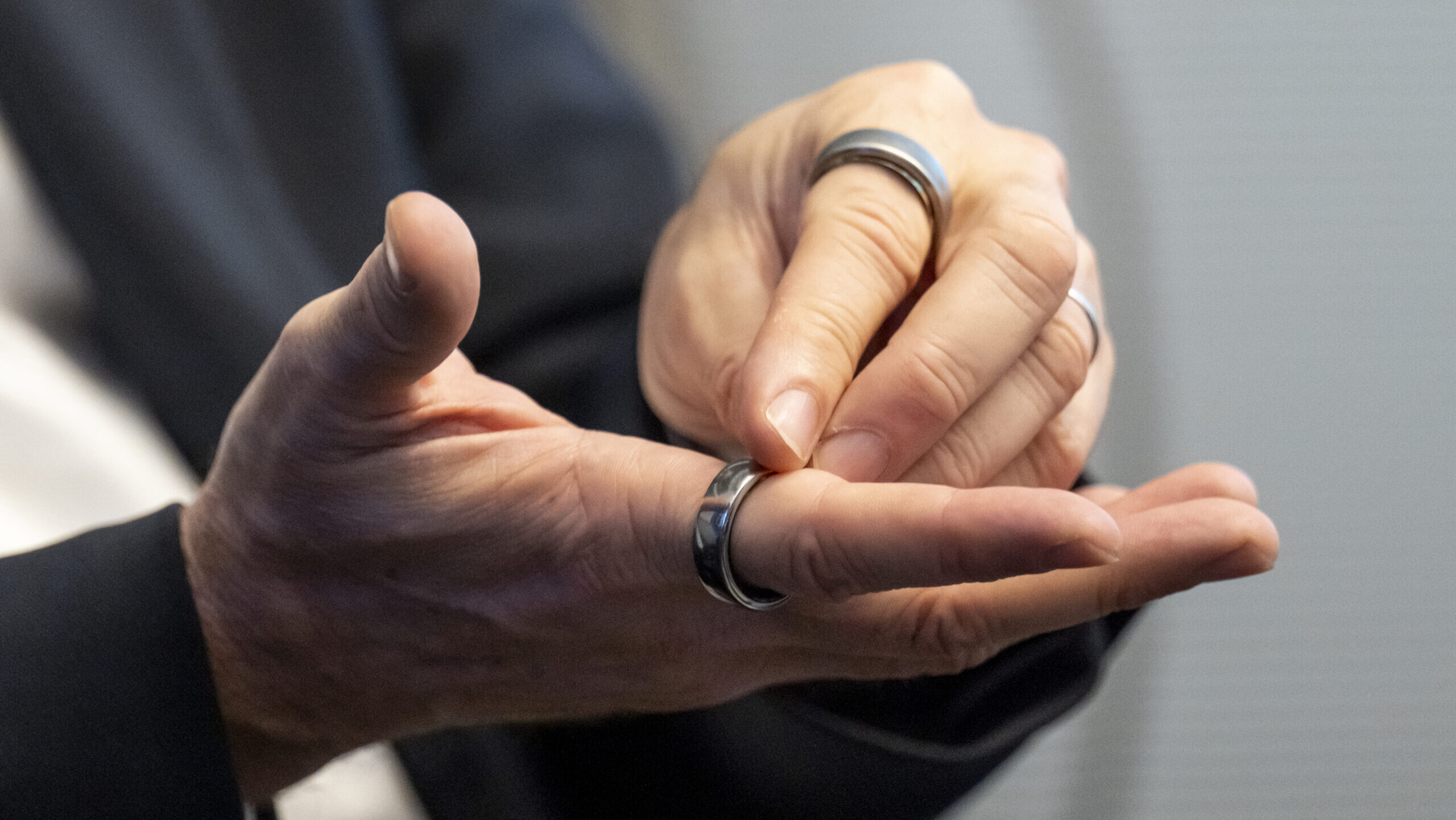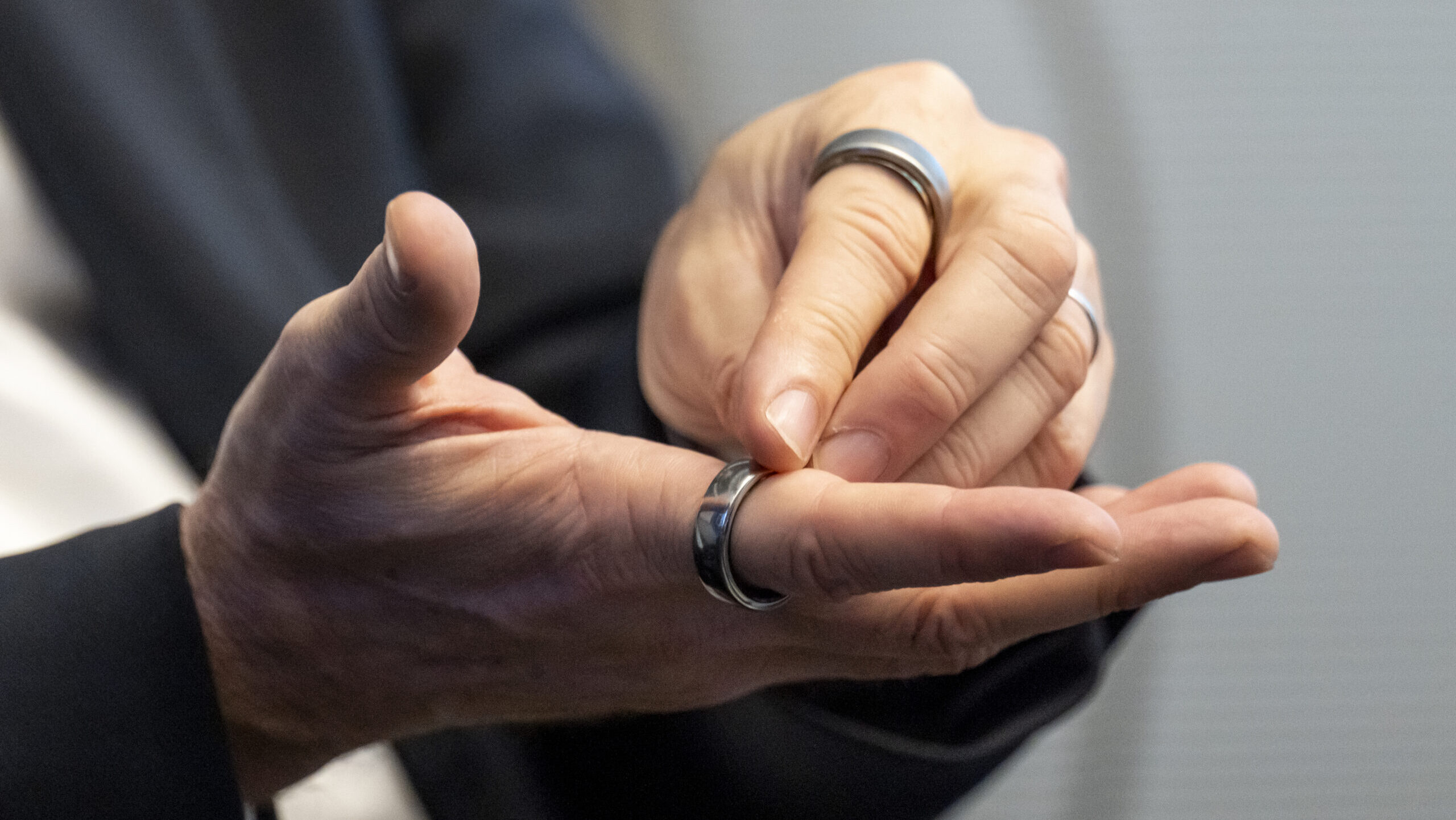
Tom Hale, chief executive officer of Oura Health Oy, wears an Oura Ring during an interview in San Francisco, California, US, on Friday, June 14, 2024. ( David Paul Morris/Bloomberg via Getty Images)
WASHINGTON – A contract to provide the Defense Health Agency (DHA) with millions of dollars of biometric trackers has been hit with a second protest, with accusations that the agency is seeking to tailor the contract to give it to a preferred vendor.
The issue puts a spotlight on the Pentagon’s attempts to work with new technology firms, and has raised the ire of a member of Congress — all against the looming backdrop of expected cuts to acquisition programs at the Department of Defense, as Secretary of Defense Pete Hegseth and Elon Musk’s Department of Government Efficiency, or DOGE, team get the knives out.
Last August, the DHA put up a notice on the government contracting site Sam.gov, announcing it was going to sole-source a $96 million contract for wearable devices and a “wellbeing platform” to Ouraring, the US subsidiary of Finnish firm Oura Health. The wellbeing platform refers to a system that takes data from a user’s wearable device, for example a ring, watch or band, and creates a custom plan based on what the user’s biometrics indicate needs improvement.
The company’s rings had become a popular device among members of the military during the COVID-19 pandemic, and now, it seemed DHA planned to outfit its team of nurses and doctors with the items in order to better track biometric data. While $96 million isn’t major by Pentagon standards it was a big win for Oura; for comparison, its December series D round of fundraising was $200 million.
But it didn’t take long for the deal to hit a snag. Wearable company WHOOP contacted the Government Accountability Office, protesting the award, saying the intent to sole source lacked sufficient information. Shortly after, the DHA wrote to GAO that they were going to cancel the sole source contract and requested that the WHOOP protest be dismissed. (Breaking Defense obtained a copy and verified the protest documents.)
Then, when the initial contract was cancelled, another request for information and subsequent request for proposal was posted to Sam.gov by the DHA in November and December respectively, specifying that the wearable must be a ring — something WHOOP says was designed to still hand the award over to Oura by default. DHA has acknowledged to lawmakers that Oura is the only wearable ring company that is cleared by DoD for use in secure facilities, according to documents reviewed by Breaking Defense.
So in January, WHOOP issued a second, previously unreported, protest. A response is due by mid-April.
“WHOOP is eager to compete on a level playing field for the opportunity to provide wearables and wellbeing solutions to our warfighters and all those who support them. We regret that DHA leadership has decided, for no discernibly valid reason, to effectively sole source this requirement to a foreign company,” a WHOOP spokesperson wrote in a statement to Breaking Defense.
“In this case, the agency’s ‘ring-based form factor’ requirement is unnecessarily restrictive, excluding companies constituting more than 97% of the current commercial market. We hope that DHA leadership reconsiders its approach and allows innovative American companies like WHOOP to compete.”
Neither Oura nor DHA responded to requests for comment by press time.
Rep. Morgan Luttrell, R-Texas, a member of the House Armed Services Committee’s Cyber, Information Technologies and Innovation subcommittee, told Breaking Defense that he was alarmed by what seems to be a push to sole-source the deal.
“It is the responsibility of the Department of Defense to ensure that our warfighters have access to the newest biometric technology by spreading funding across multiple wearable biometric companies, rather than relying on a single provider,” Luttrell wrote in a statement to Breaking Defense.
“Competition drives innovation, strengthens national security, and ensures our warfighters get the best gear possible. Relying on a single provider limits options and slows progress,” he added.
When Breaking Defense asked Luttrell’s office if he plans on advising the DHA to reconsider their choice in exclusively soliciting for a ring option, a spokesperson told Breaking Defense, “Rep. Luttrell thinks that different biometric monitoring devices serve distinct purposes and exclusively investing in the Oura Ring raises concerns. Our office is reviewing the matter and will provide updates soon!”
One Ring To Rule Them All?
The Pentagon’s interest in wearable technology puts Oura and other wearable creators in good company.
According to one report, the wearable technology market size is worth roughly $70.3 billion. Another report puts that number at $74.6 billion. Regardless of the actual figure, it’s clear it’s a growing business — and one that the DoD can find many uses for, given the focus on health and fitness in the military.
But wearables come in many sizes and shapes, so to get the best results, the user should be given choices to find what fits best for them, Sam Howell, an associate fellow with the Technology and National Security Program at the Center for a New American Security (CNAS), told Breaking Defense.
“Having continuous data is the most important thing. People aren’t going to wear the device unless it’s comfortable [for] them. So, I do think there is a lot of benefit in giving folks some flexibility to choose what’s most comfortable for them and their lifestyle,” said Howell.
“Another big component is they have to trust that the device is accurate, or they’re not necessarily going to put any stock in the insights that are gleaned from them, and then the whole point is kind of defeated. So if there’s a service member that, for example, trusts the Ouraring more than, let’s just say, a Garmin, I do think there’s value in allowing them to use the device they personally trust the most.”
Asked to speculate why DHA may be emphasizing the ring option, Howell said in her experience rings “probably give the most accurate heart rate reading, because it’s directly on your finger.” However, she noted that doctors usually take off rings to perform surgeries — the kind of situation where you most want biometric data, if you’re trying to understand how someone is operating at their peak.
Jerry McGinn, executive director of the Greg and Camille Baroni Center for Government Contracting at George Mason University, told Breaking Defense that though there is “likely” a reason the DHA is choosing a ring, “it would be helpful if they explain their rationale in their RFI and RFP,” something both solicitations did not include.
“Whether that’s grounds for GAO to uphold the protest, I don’t know,” he added. “It is a little surprising that after the protest of the sole source award, that the government wouldn’t explain a bit more their rationale for seeking a ring solution as opposed to other solutions.”
No one involved could have realized it when the protest began, but the contract dispute may be coming at a bad time.
Members of DOGE, the Elon Musk-organized group that has been actively seeking government cuts on behalf of the White House, arrived at the Pentagon this week. And while $96 million may not seem like a lot of money, it feels like everything in the so-called “fourth estate” —the parts of the Pentagon that, like DHA, don’t fall under the services — is at risk.
“I think pretty much every contract or solicitation that’s out there has got a lot of uncertainty now, so that is for darn sure,” McGinn said.
And while he said he could see reasons for the wearable contract to go through, “there’s bound to be some kind of changes” with DoD acquisition spending. Which potentially means that whomever ends up prevailing in this fitness tracker dispute may still have to sweat out if they’ll be getting their money.











